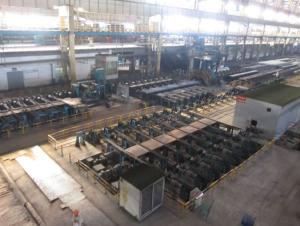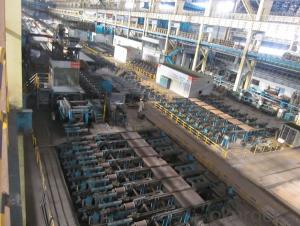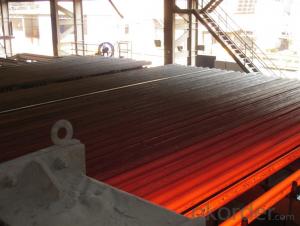Prime quality square alloy steel billet 90mm Q235
- Loading Port:
- Tianjin
- Payment Terms:
- TT OR LC
- Min Order Qty:
- 100 m.t.
- Supply Capability:
- 10000 m.t./month
OKorder Service Pledge
OKorder Financial Service
You Might Also Like
Structure of Prime quality square alloy steel billet 95mm Q235

Description of Prime quality square alloy steel billet 95mm Q235
1. Prepainted steel coil is coated with organic layer, which provides higher anti-corrosion property and a longer lifespan than that of galvanized or galvalume steel sheets.
2. The base metals for prepainted steel coil consist of cold rolled, HDGI Steel, electro-galvanized and hot-dip alu-zinc coated steel. The finish coats of prepainted steel coil can be classified into groups as follows: polyester, silicon modified polyesters, polyvinylidene fluoride, high-durability polyester, etc.
3. The production process has evolved from one-coating-and-one-baking to double-coating-and-double-baking, and even three-coating-and-three-baking.
4. The color of the prepainted steel coil has a very wide selection, like orange, cream-colored, dark sky blue, sea blue, bright red, brick red, ivory white, porcelain blue, etc.
5. The prepainted steel coils can also be classified into groups by their surface textures, namely regular prepainted sheets, embossed sheets and printed sheets.

Main Feature of Prime quality square alloy steel billet 95mm Q235
Uncoated CR steel sheet
With the features of in line with the international highest standards in demension and shape, excellent surface finish and properties, the products are mainly used in home appliance and automobile industries.
Galvanized steel sheet(include HDG and EG)
With the features of good corrosion resistance, the products are mainly used in automobile, home appliance, electronics, building and machinery manufacture industries, etc.
Precoated steel sheet
With the features of enviromental protection and good processablility, long lasting surface durability, rich in colors, the products are maily used in building, home appliance and furniture industries, etc.
Applications of Prime quality square alloy steel billet 95mm Q235
Construction
Manufacture anticorrosion, industrial and civil architecture roof boarding, roof grille
Light industries
Home appliance's case, civil chimney, kitchen utensils
Auto industry
Corrosion resistant parts of cars
Agriculture
Food storage, meat and aquatic products' freezing and processing equipment
Commerce
Equipments to store and transport materials, and packing implements

Specifications of Prime quality square alloy steel billet 95mm Q235
Product | Prime quality square alloy steel billet 95mm Q235 |
Material Grade | SGCC / SGCH / DX51D+AZ, etc |
Thickness | 0.6-3.0mm |
Width | 500-1500mm |
Tolerance | Thickness: +/-0.02mm , Width:+/-2mm |
Zinc-coating | Z30-150g/m2 |
Technique | Raw material: Hot rolled steel coil --> Cold rolled_>hot dipped galvalume |
Surface | Dried, Chromated, Unoiled |
Spangle | Regular spangle , small spangle, zero spangle |
ID | 508MM 610MM |
Coil weight | 1-25MT |
Export package | Cardboard inner sleeves, Waterproof paper, galvanized steel covered and steel strip packed |
FAQ of Prime quality square alloy steel billet 95mm Q235
We have organized several common questions for our clients,may help you sincerely:
1. How Can I Visit There?
Our company is located in Tianjin City, China, near Beijing. You can fly to Tianjin Airport Directly. All our clients, from home or aboard, are warmly welcome to visit us!
2. How Can I Get Some Sample?
We are honored to offer you sample.
3. Why choose CNBM?
Our delivery time about 15-20days for standard sizes, if you have other requirements like hardness, quanity and width ,it is about 20-40days. But don't worry we also try our best for the delivery time ,because time longer and our cost is higher.
- Q:How are steel billets used in the manufacturing of shipbuilding components?
- Steel billets are used in the manufacturing of shipbuilding components as they serve as the raw material for forging, rolling, and shaping various structural parts of a ship, such as hull sections, bulkheads, and frames. These billets are heated and formed into desired shapes through processes like hot rolling, forging, or extrusion, ensuring the required strength, durability, and dimensional accuracy of the shipbuilding components.
- Q:How are steel billets used in the manufacturing of machinery?
- Steel billets are an essential component in the manufacturing of machinery due to their versatility and strength. These cylindrical metal bars, typically made from carbon or alloy steel, serve as the raw material that is transformed into various machine parts and components. One common application of steel billets in machinery manufacturing is for the production of machine frames and structures. The billets are heated and then hot-rolled or forged into the desired shape, ensuring the final product has the necessary strength and durability to withstand the mechanical stresses it will encounter during operation. Additionally, steel billets are used to create machine components such as gears, shafts, and axles. These parts require high tensile strength and resistance to wear and deformation, making steel billets the ideal material choice. The billets are typically machined or forged into the desired shape, ensuring precise dimensions and tolerances are met. Furthermore, steel billets can also be used in the manufacturing of machine tools, which are crucial for shaping and machining various materials. By using steel billets as the base material, machine tools can effectively handle heavy loads, provide stability, and ensure precision in the manufacturing processes. In summary, steel billets are integral to the manufacturing of machinery, as they provide the necessary strength, durability, and versatility required for the production of machine frames, components, and tools. Their ability to be shaped, machined, and forged into various forms allows for the creation of high-quality machinery that can effectively perform its intended functions.
- Q:If the casting speed is not steady, what will happen to the billet?
- The instability of the casting speed leads to the unstable surface of the mould and increases the probability of slag entrapment in the mold.
- Q:How are steel billets measured?
- To ensure accurate dimensions and specifications, various techniques and tools are employed in measuring steel billets. One commonly utilized approach involves the utilization of calipers or micrometers. These tools enable precise measurements of the billet's diameter, length, and other necessary dimensions. Apart from physical measurements, non-destructive testing methods like ultrasonic testing or eddy current testing are also applied to steel billets. These techniques effectively identify any internal defects or inconsistencies within the billet, thus guaranteeing its quality and integrity. Moreover, the mass of steel billets is often determined through weighing. Depending on the size and weight of the billet, different weighing scales or load cells are employed for this purpose. The weight measurement plays a vital role in determining the billet's mass per unit length, which is crucial for calculating its density and other mechanical properties. In summary, the measurement of steel billets is an essential stage in the manufacturing process. It ensures that the billets meet the necessary specifications for further processing and utilization in diverse industries such as construction, automotive, and manufacturing.
- Q:What are the different types of tests conducted on steel billets?
- There are several different types of tests that are conducted on steel billets to ensure their quality and suitability for various applications. These tests are essential in determining the mechanical properties, chemical composition, and integrity of the steel billets. 1. Chemical Composition Analysis: This test involves examining the chemical composition of the steel billets to ensure that they meet the required standards and specifications. It measures the levels of various elements such as carbon, manganese, silicon, sulfur, and phosphorus. 2. Tensile Test: This test measures the tensile strength, yield strength, and elongation of the steel billets. It helps determine the ability of the steel to withstand pulling forces without breaking. 3. Hardness Test: This test determines the hardness of the steel billets, which is essential in evaluating their resistance to wear, deformation, and penetration. Commonly used hardness tests include Brinell, Rockwell, and Vickers tests. 4. Impact Test: This test measures the toughness and ability of the steel billets to absorb energy under impact or sudden loading conditions. It helps determine their resistance to fracture and cracking. 5. Ultrasonic Testing: This non-destructive test uses high-frequency sound waves to detect internal flaws or defects in the steel billets. It is commonly used to detect cracks, voids, and inclusions that may affect the structural integrity of the billets. 6. Dimensional Inspection: This test ensures that the steel billets meet the specified dimensional requirements, including length, width, and thickness. It ensures that the billets are suitable for their intended application and can be used in subsequent manufacturing processes without any issues. 7. Macroscopic Examination: This visual inspection involves examining the surface and internal structure of the steel billets using magnification. It helps identify any visible defects such as cracks, porosity, segregation, or any other irregularities. 8. Microscopic Examination: This test involves examining the microstructure of the steel billets using a microscope. It helps determine the grain size, presence of phases, and any abnormalities in the steel structure that may affect its properties. These tests collectively ensure that the steel billets meet the required quality standards and possess the necessary mechanical properties for their intended applications. They help ensure the safety, reliability, and performance of the steel billets in various industries such as construction, automotive, aerospace, and manufacturing.
- Q:What are the main factors affecting the mechanical properties of steel billets?
- The main factors affecting the mechanical properties of steel billets include the composition of the steel, the heat treatment process, the grain size, and the presence of impurities or defects in the metal.
- Q:How do steel billets contribute to the manufacturing of telecommunications equipment?
- Steel billets play a crucial role in the manufacturing of telecommunications equipment by providing the necessary raw material for various components and structures. These billets, typically made from carbon steel, are semi-finished products that are further processed to create specific shapes and sizes required for telecommunications equipment. One of the key ways steel billets contribute to the manufacturing of telecommunications equipment is by serving as the base material for the fabrication of towers and masts. These structures are vital for the installation of antennas and satellite dishes, enabling the transmission and reception of signals for telecommunications networks. Steel billets are shaped and welded to create sturdy and durable towers that can withstand various environmental conditions. Moreover, steel billets are also used in the production of enclosures and cabinets for housing telecommunication equipment. These enclosures provide protection from external factors such as dust, moisture, and vandalism, ensuring the proper functioning and longevity of the equipment. Steel billets are formed into panels, frames, and chassis that are then assembled to create robust enclosures that can withstand harsh environments. In addition, steel billets contribute to the manufacturing of telecommunications equipment by being used in the production of cable trays and supports. These components are essential for organizing and routing cables, providing a neat and efficient infrastructure for telecommunications systems. Steel billets are rolled and formed into various shapes, such as channels and angles, to create sturdy cable trays and supports that can handle the weight and stress of multiple cables. Furthermore, steel billets are also utilized in the fabrication of connectors and brackets for telecommunications equipment. These small yet crucial components provide the necessary connections and support for different devices and modules in telecommunications systems. Steel billets are machined, drilled, and shaped into specific designs to create reliable connectors and brackets that ensure proper functionality and stability. Overall, steel billets play a vital role in the manufacturing of telecommunications equipment by providing the necessary raw material for various components and structures. Their strength, durability, and versatility make them an ideal choice for creating robust and reliable equipment that can withstand the demands of modern communication networks.
- Q:What are the main factors affecting the formability of alloy steel billets?
- The formability of alloy steel billets, which refers to the ability of the material to be shaped or formed without cracking or fracturing, is influenced by several key factors. 1. Alloy composition: The alloy composition of steel billets plays a significant role in determining their formability. Different alloying elements such as carbon, manganese, chromium, and nickel can alter the mechanical properties of the steel, including its ductility and toughness. Higher levels of certain elements can improve formability, while excessive amounts can lead to brittleness and reduced formability. 2. Grain size and structure: The grain size and structure of the steel billets also affect formability. Fine-grained structures have better formability compared to coarser grain sizes. This is because fine grains allow for more uniform deformation and reduce the likelihood of localized strain concentration, which can lead to cracking. 3. Temperature: The temperature at which the steel billets are processed greatly influences their formability. The material's ductility and ability to deform without cracking are generally enhanced at higher temperatures. This is due to the reduction in the material's yield strength and increased plasticity. However, excessively high temperatures can also lead to excessive grain growth and decreased formability. 4. Strain rate: The rate at which the steel billets are deformed is another important factor. Higher strain rates can result in reduced formability, as the material may not have sufficient time to accommodate the deformation before fracture occurs. Controlling the strain rate during forming processes is crucial to ensure optimal formability. 5. Lubrication: The use of lubricants during the forming process can significantly improve the formability of steel billets. Lubricants reduce friction between the material and the forming tools, minimizing the risk of sticking or tearing. They also help dissipate heat generated during deformation, preventing excessive temperature rise that can negatively impact formability. 6. Forming process: The specific method used to shape the steel billets can also affect formability. Different processes, such as forging, rolling, or extrusion, impose varying levels of strain and stress on the material. Each process has its own limitations and requirements for optimal formability, and selecting the appropriate forming method is crucial to achieve the desired shape without compromising the material's integrity. In summary, the formability of alloy steel billets is influenced by their alloy composition, grain size and structure, temperature, strain rate, lubrication, and the chosen forming process. Understanding and controlling these factors are essential for achieving the desired shape and avoiding defects or failures during the forming of alloy steel billets.
- Q:What is the size and shape of steel billets?
- Steel billets come in a variety of sizes and shapes, depending on their intended use. Generally, they are rectangular in shape and can range in size from small to large dimensions. The length of a billet can vary from several inches to several feet, while the width and height can also vary accordingly. These dimensions are determined by the specific requirements of the steel manufacturing process and the desired end product. Additionally, steel billets can also be customized to have specific shapes, such as square or round, to cater to different production needs.
- Q:What are the main factors affecting the surface quality of steel billets?
- The surface quality of steel billets is influenced by several factors. Firstly, the cleanliness of the steel plays a crucial role. Contaminants such as oxides, scale, and inclusions can negatively impact the surface quality. These impurities can cause defects like pits, cracks, and roughness on the surface. Secondly, the temperature during the steelmaking process is an important factor. If the steel is overheated, it can lead to excessive scaling and oxidation, resulting in a poor surface finish. On the other hand, if the steel is not heated adequately, it may have a non-uniform surface and inconsistent mechanical properties. Additionally, the presence of residual stresses can affect the surface quality. Uneven cooling or improper heat treatment can cause residual stresses, leading to surface cracks, warping, or distortion. The type and effectiveness of the surface treatment or finishing processes also impact the surface quality of steel billets. Processes like grinding, polishing, or shot blasting can improve the surface finish by removing defects and creating a smoother surface. Moreover, the quality of the equipment and tools used in steel production plays a significant role. Worn-out or poorly maintained machinery can result in surface defects, inadequate surface preparation, or improper handling, affecting the final surface quality. Lastly, the composition and microstructure of the steel itself influence the surface quality. Variations in alloying elements, grain size, and phase distribution can affect the surface finish, hardness, and overall quality of the billets. In conclusion, the main factors affecting the surface quality of steel billets include cleanliness, temperature control, residual stresses, surface treatment processes, equipment quality, and the composition of the steel. Addressing these factors through proper steelmaking practices, surface treatments, and quality control measures is crucial for achieving high-quality steel billets with superior surface finish.
1. Manufacturer Overview |
|
|---|---|
| Location | |
| Year Established | |
| Annual Output Value | |
| Main Markets | |
| Company Certifications | |
2. Manufacturer Certificates |
|
|---|---|
| a) Certification Name | |
| Range | |
| Reference | |
| Validity Period | |
3. Manufacturer Capability |
|
|---|---|
| a)Trade Capacity | |
| Nearest Port | |
| Export Percentage | |
| No.of Employees in Trade Department | |
| Language Spoken: | |
| b)Factory Information | |
| Factory Size: | |
| No. of Production Lines | |
| Contract Manufacturing | |
| Product Price Range | |
Send your message to us
Prime quality square alloy steel billet 90mm Q235
- Loading Port:
- Tianjin
- Payment Terms:
- TT OR LC
- Min Order Qty:
- 100 m.t.
- Supply Capability:
- 10000 m.t./month
OKorder Service Pledge
OKorder Financial Service
Similar products
New products
Hot products
Related keywords
































